Physical Address
304 North Cardinal St.
Dorchester Center, MA 02124
Current critical care supportive measures make it possible for patients with severe injuries and physiologic impairment to survive what otherwise might have been lethal conditions. One of the major surgical consequences of extensive resuscitation efforts regards the condition of the abdominal wall. Although the objective should be to always close the abdomen following laparotomy, primary closure may be technically impossible or deleterious owing to any number of conditions. In this chapter, we will discuss the management of the posttraumatic abdominal wall, beginning with a discussion of abdominal compartment syndrome (ACS). This will be followed by a review of damage control principles and temporary abdominal closure (TAC). The chapter will conclude with a discussion of special considerations of the open abdomen, including abdominal wall reconstruction, nutritional support, and outcomes.
The effects of intraabdominal hypertension (IAH) were first described in 19th century by Marey and Burt, who identified the relationship between intrathoracic pressure and elevated intraabdominal pressure (IAP). The term “abdominal compartment syndrome” was popularized over a century later when both Kron and associates and Richards and colleagues reported separate series of patients who developed tense, abdominal distention with elevated pulmonary pressures and increased IAPs postoperatively despite normal mean arterial blood pressure and cardiac performance. All of these patients improved with abdominal decompression. Although primary compartment syndrome may develop as a direct result of intraabdominal injuries, ACS has also been shown to develop as a consequence of resuscitation in the absence of abdominal injuries and thus should be considered potentially preventable ( Fig. 1 ).
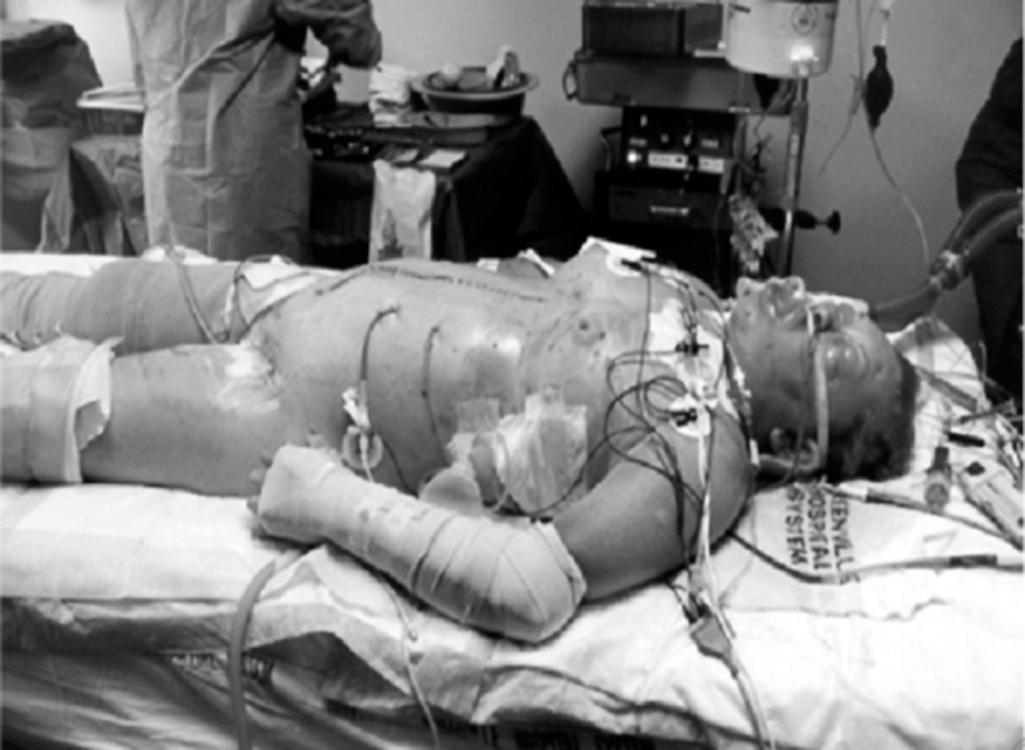
Owing to the wide variety of proposed definitions, the World Congress on Abdominal Compartment Syndrome (WCACS) was established and has endorsed a definitive classification system. IAH is defined as IAP higher than 12 mm Hg and is further graded from I to IV ( Box 1 ).
Grade I: IAP 12–15 mm Hg
Grade II: IAP 16–20 mm Hg
Grade III: IAP 21–25 mm Hg
Grade IV: IAP > 25 mm Hg
IAP, Intraabdominal pressure; WCACS, World Congress on Abdominal Compartment Syndrome.
Generically, a compartment syndrome is a condition in which increased pressure in a confined space adversely effects the circulation and threatens the function and viability of the tissue within the space. Compartment syndromes may occur in the extremities, orbital globe, cranium, and abdominal cavity. ACS refers to a clinical entity in which IAH reduces blood flow to abdominal organs and impairs pulmonary, cardiovascular, renal, and gastrointestinal (GI) function. The development of ACS is dependent on both the degree of IAH as well as the rate of pressure increase. The definition of ACS according to the WCACS is IAP higher than 20 mm Hg with new onset of multiple-organ failure ( Fig. 2 ).
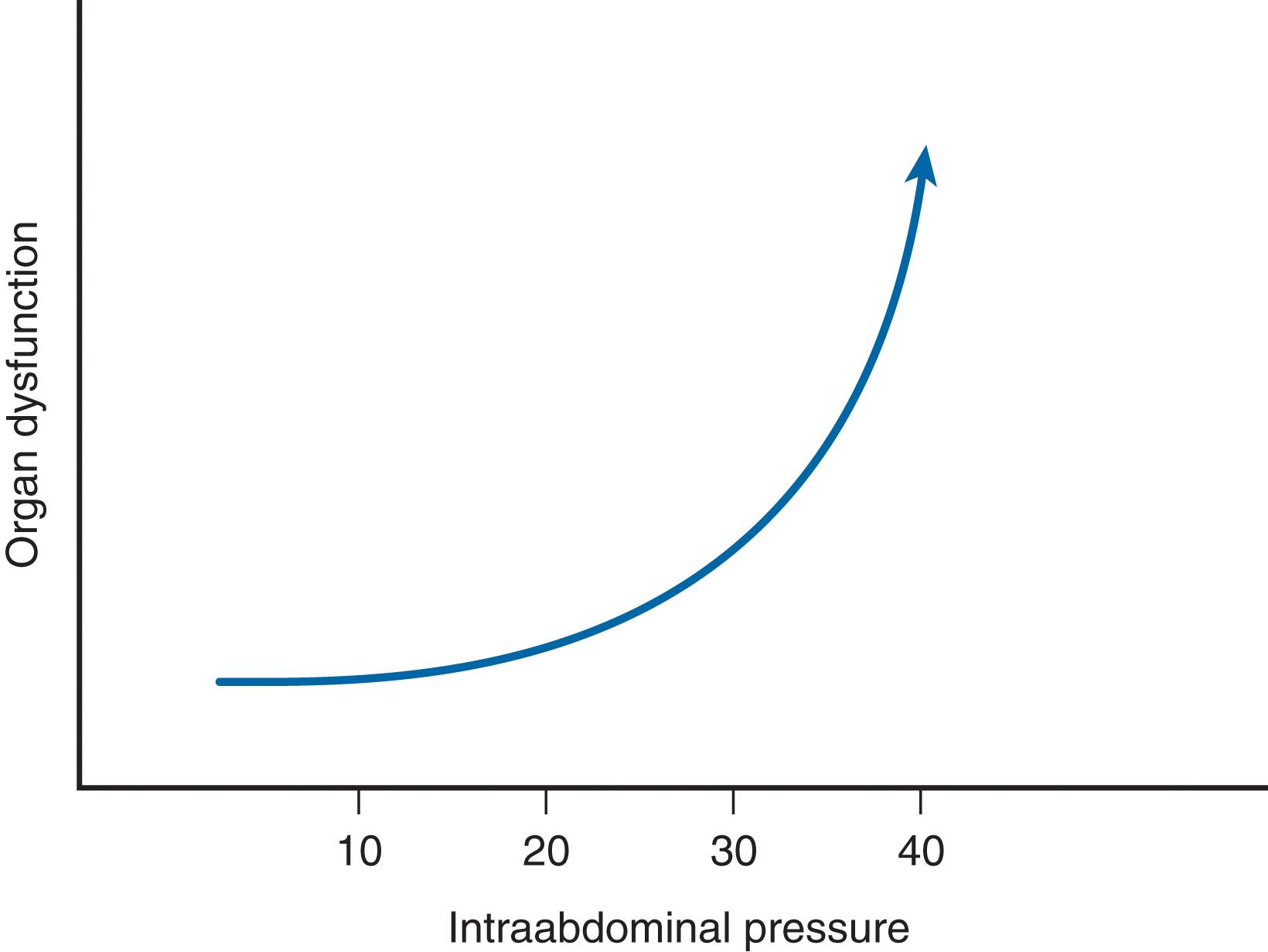
ACS may be further characterized as follows:
Primary/acute : Intraabdominal injury is directly and proximally responsible for the compartment syndrome.
Secondary : No visible intraabdominal injury is present but injuries outside the abdomen cause fluid accumulation. (Differentiation between the primary and secondary ACS may be important as secondary ACS has been shown to have a worse outcome.)
Chronic : ACS occurs in the presence of cirrhosis and ascites, often in the later stages of the disease.
Worsening compartment syndrome leads to fulminant multiple-organ dysfunction, and if left untreated, it is typically fatal. Critical care management in severely injured patients at risk for developing ACS should center on prevention as well as early recognition of signs and symptoms of IAH.
Although the cause of ACS is poorly understood, it represents a hyperinflammatory response and response to shock ( Fig. 3 ). The anatomic effects of ACS begin with the direct compression of intra and retroperitoneal structures. Especially affected are low-pressure systems such as the intestinal tract and venous systems, which collapse. Immediate effects such as thrombosis or bowel wall edema may be accompanied by translocation of bacterial products leading to additional fluid accumulation, further increasing IAP ( Table 1 ). At the cellular level, oxygen delivery is impaired, leading to ischemia and anaerobic metabolism. Vasoactive substances such as histamine and serotonin increase endothelial permeability, and further capillary leakage impairs red blood cell transport, leading to worsening ischemia. Although current practice management guidelines come as a result of experiences with the development of ACS in the trauma setting, it is important to recognize that the role for damage control laparotomy and open abdomen management is not exclusive to the trauma population. Various medical and surgical conditions including diffuse peritonitis, acute pancreatitis, and mesenteric ischemia may potentially expose the patient to an increased risk of developing IAH and ACS ( Box 2 ).
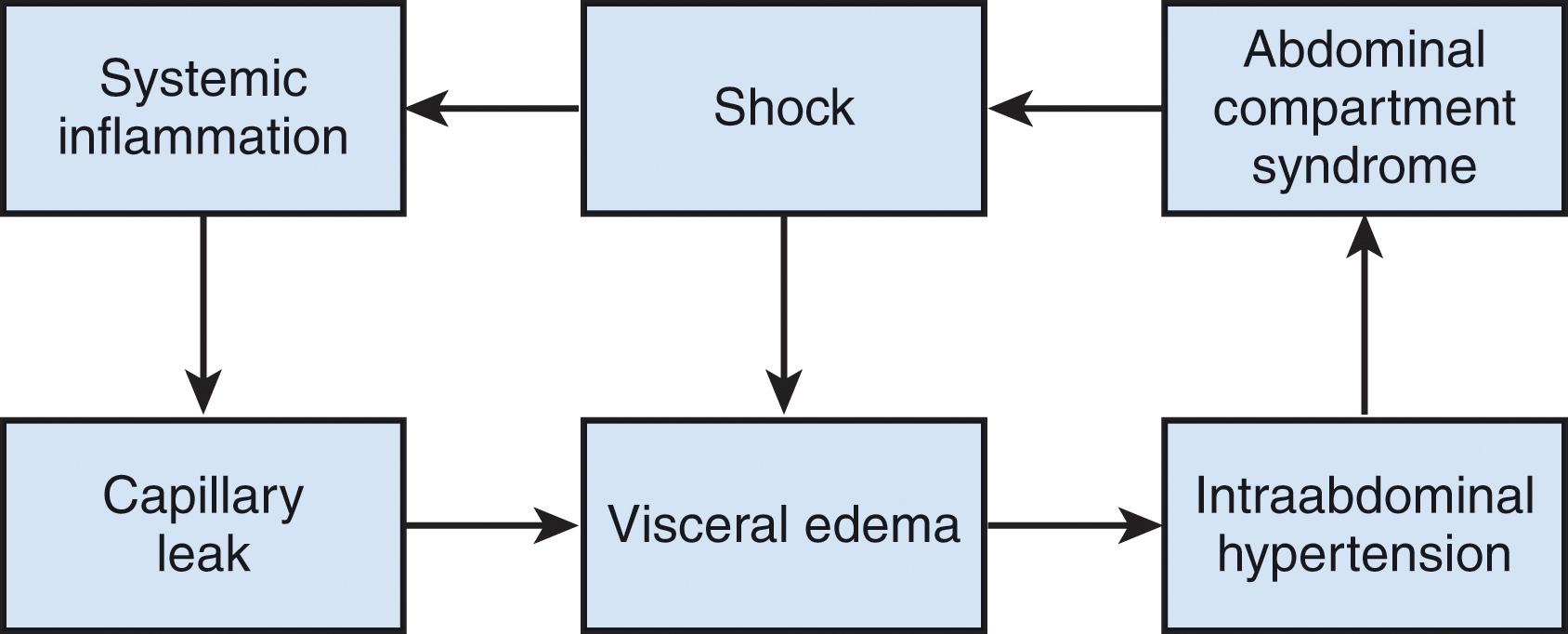
| Organ or Structure | Effect |
|---|---|
| Head | ↑ Intracranial pressure |
| ↓ Cerebral perfusion pressure | |
| Heart | ↓ Cardiac output |
| ↓ Venous return | |
| ↑ Pulmonary artery occlusion pressure and central venous pressure | |
| Lungs | ↑ Systemic vascular resistance |
| ↑ Peak inspiratory pressure | |
| ↑ Pulmonary artery wedge pressure | |
| ↓ Dynamic compliance (Cdyn) | |
| ↑ Arterial oxygen pressure (Pao 2 ) | |
| ↑ Arterial carbon dioxide pressure (Paco 2 ) | |
| ↑ Intrapulmonary shunt (Qsp/Qt) | |
| ↑ Fraction of dead space to total expired tidal volume (V d /V t ) | |
| Liver | ↓ Portal flow |
| ↓ Mitochondria | |
| ↑ Lactate | |
| Kidney | ↓ Urine output |
| ↓ Renal flow | |
| ↓ Glomerular filtration rate (GFR) | |
| Intestines | ↓ Celiac flow |
| ↓ Superior mesenteric arterial (SMA) flow | |
| ↓ Mucosal flow | |
| Abdominal wall | ↓ Compliance |
| ↓ Rectus flow |
Posttraumatic hemorrhage
Intraperitoneal bleeding
Retroperitoneal bleeding
Extraperitoneal bleeding
Any patient who requires vigorous fluid resuscitation from shock of any cause
Postresuscitative visceral edema
“Deadly triad”—hypothermia, acidosis, coagulopathy
Frequent prelude to abdominal compartment syndrome
Other risk factors for the development of ACS include ascites or intraabdominal fluid accumulation, intra or retroperitoneal hemorrhage/hematoma, requirement of renal replacement therapy, pregnancy, abdominal burns, massive volume resuscitation, abdominal packing for control of hemorrhage, reperfusion injury following bowel ischemia, ileus and bowel obstruction, intraabdominal masses, and closure of the abdomen under undue tension.
The most practical and reliable method of measuring IAPs is through the urinary bladder, which acts as a passive conduit. The urinary bladder transmits IAPs without imparting any additional pressures from its own musculature. Saline is injected into the fully drained bladder. A Foley catheter is clamped distal to the aspiration port and a 16-G needle is inserted into this port, which is then attached to a transducer system with the iliac crest used as the zero reference point. Commercial kits are also available for measuring bladder pressures.
Prevention of ACS requires identification of an at-risk patient, timely surgical intervention for the primary problem (e.g., hemorrhage), and judicious fluid management. Medical management is limited to sedation/chemical paralysis, gastric and bladder decompression, reduced tidal volume ventilator strategies, fluid restriction, and diuresis. However, more severe forms of compartment syndrome necessitate surgical intervention, including early decompressive laparotomy. Although decompression can be performed safely as a bedside procedure in the intensive care unit (ICU), hemorrhagic sources of ACS may be best managed in the operating room ( Fig. 4 ). Once completed, decompressive laparotomy often rapidly reverses adverse effects of ACS and improves oxygenation and pulmonary compliance, returning peak inspiratory pressures toward normal and promptly reversing the oliguria with brisk diuresis. Before decompression, attempts to correct acid-base and electrolyte disturbances (including potassium, magnesium, and calcium imbalance) may avoid cardiac dysrhythmias after decompression. Maintenance of the open abdomen after decompression necessitates the maintenance of an open abdomen or laparostomy with TAC ( Fig. 5 ).
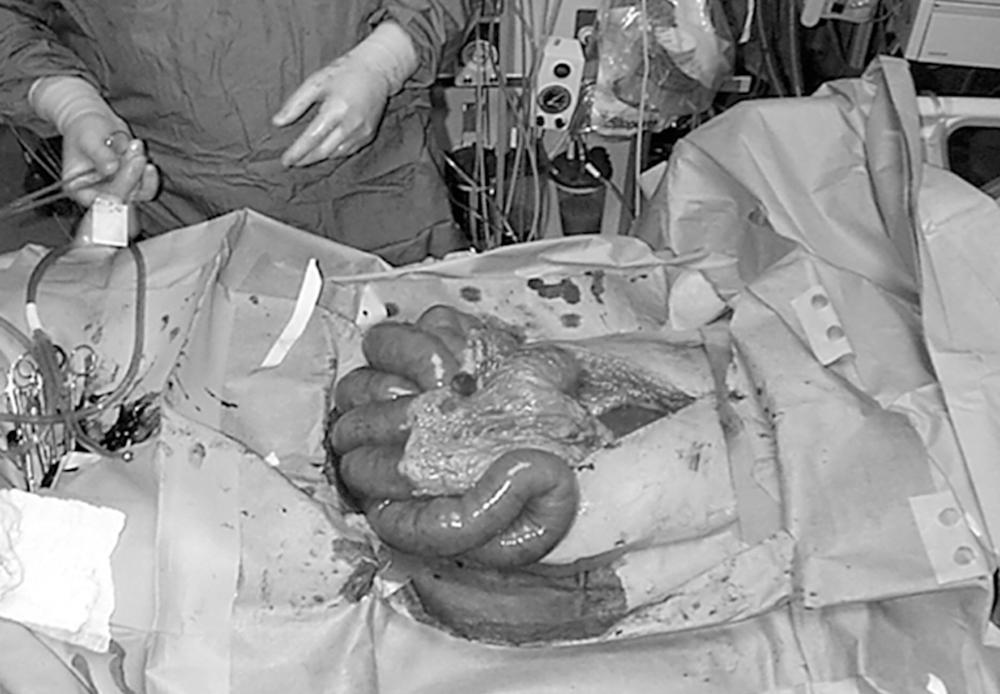
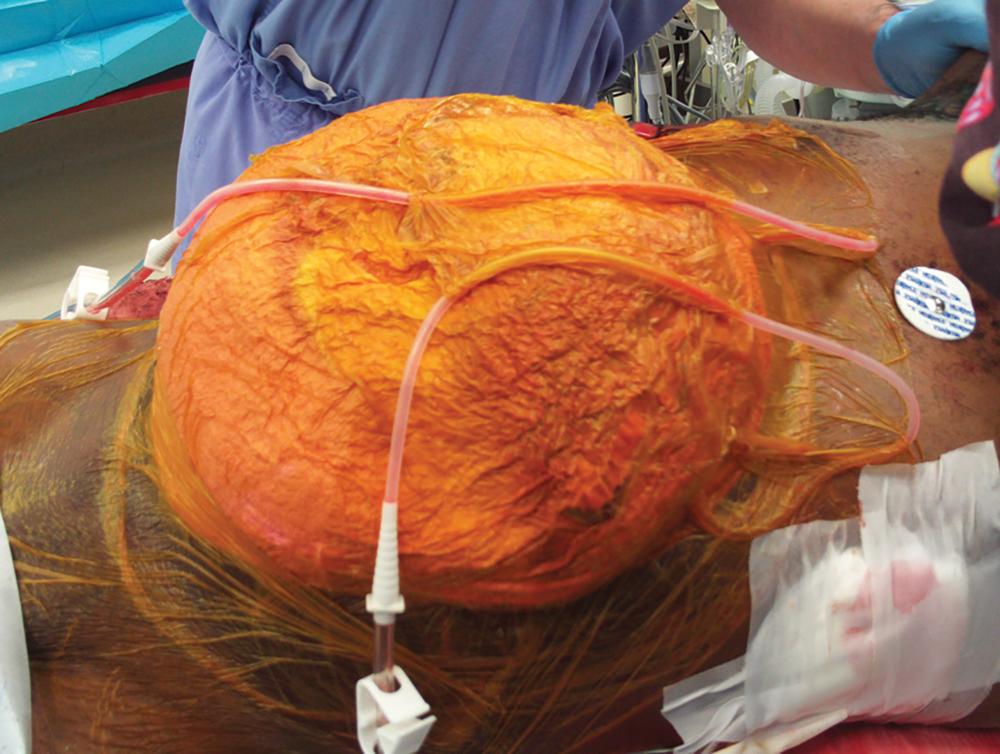
Untreated ACS is presumed to be uniformly fatal, although survival rate may be limited to as low as 50% despite abdominal decompression. Although IAH is part of the progression to ACS, IAH alone may not adversely affect outcome such as multiple-organ failure and fatality. In terms of prevention of ACS, identification of IAH is essential so that medical or surgical measures may be undertaken to halt the progression of the syndrome.
Damage control surgery represents one of the major advances in the surgical management of patients in extremis over the past 20 years. Traditionally, damage control has been defined as follows:
Rapid control of bleeding and contamination
TAC
Physiologic resuscitation of metabolic failure
Delayed definitive operation
This paradigm shift in the surgical management of the multi-injured trauma patient evolved with the recognition that patients in extremis were more likely to die from their intraoperative metabolic failure than from a failure to complete operative repairs. Characterized in part by the “lethal triad” of coagulopathy, hypothermia, and metabolic acidosis, metabolic failure frequently results in death. The impetus is on the operating surgeon to recognize this physiology and anticipate the need to perform damage control based on a rapid initial injury inventory because a failure to do so may increase risk for fatality.
In an effort to solve one problem, another has been created: the posttraumatic open abdomen. By necessity this patient is left with a temporary, large, postoperative ventral hernia with the abdominal viscera covered by a temporary dressing or closure. Many lessons have been learned in managing the complications associated with these critically ill patients and through these lessons, four essential principles in the management of the open abdomen have evolved:
Protection of the bowel
Preservation of the fascia to prevent domain loss
Early fascial closure if at all possible
Minimizing planned ventral hernia and delayed reconstruction
One of the earliest descriptions of damage control techniques was by Pringle in 1908 who described the use of gauze packs for hemorrhage control in the setting of hepatic trauma. Although these techniques were later discouraged based on wartime experience, interest in an abbreviated abdominal operation for severe trauma was rekindled toward the latter half of the 20th century. With the first description of the “bailout” technique in Harlan Stone’s seminal publication, the era of abbreviated laparotomy and damage control was initiated. Rotondo and colleagues’ description of improved survival when “damage control” techniques were applied to patients with severe abdominal vascular injuries helped fuel the paradigm shift away from the surgical dictum that a trauma patient’s first operation must be definitive. The current management scheme of damage control has been revised to include four stages ( Fig. 6 ).
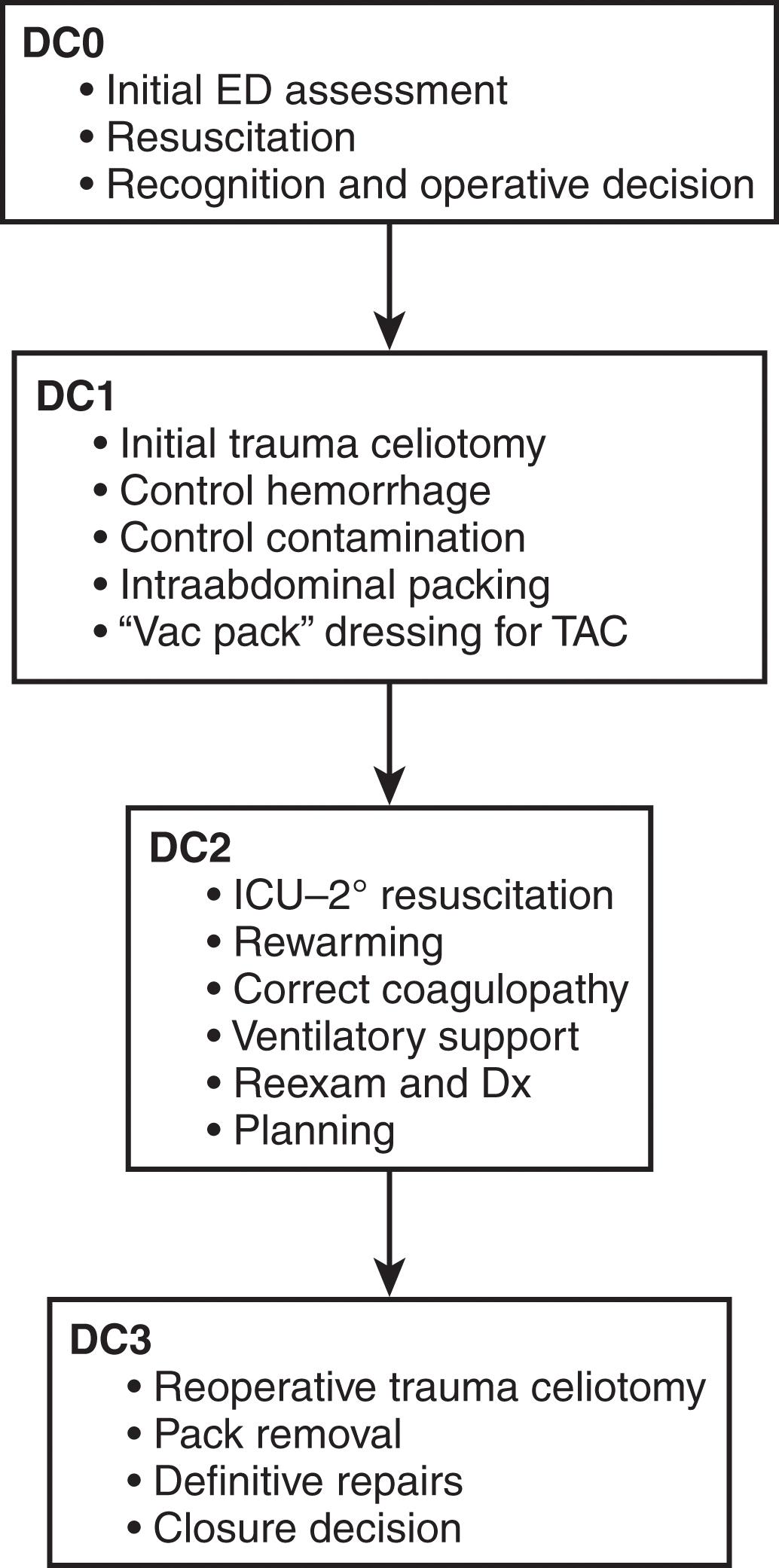
The initial preoperative assessment and resuscitation of a patient with massive hemorrhage in the emergency department can be considered as a preface to the damage control continuum (DC0). The highest priorities during DC0 are (1) identification of an exsanguinating patient and (2) initiation of blood and coagulation factor therapy while (3) preparing for definitive hemorrhage control. Resuscitation must be provided judiciously as high-volume resuscitation of blood products, coagulation factors, and crystalloid solutions may be associated with the development of ACS. Large-volume crystalloid-based resuscitation strategies should be of historical interest only and are strongly discouraged, as these not only lead to increases in IAH but also contribute to worsening of bleeding and the acute coagulopathy of trauma. Early hemostatic resuscitation is preferred with whole blood or component therapy to reverse the effects of trauma-induced coagulopathy and shock. There is growing evidence to support hypotensive resuscitation, which centers on maintenance of circulation and hemostasis irrespective of normalization of hemodynamic parameters particularly in the setting of vascular injuries. Despite some controversy in the literature, numerous reports have shown that massive transfusion with a high ratio of plasma and platelets to red blood cells improves survival in exsanguinating patients and may decrease overall transfusion requirements.
During the initial trauma laparotomy (DC1), it is important to estimate each patient’s physiologic reserve in order to make appropriate operative decisions. Physiologic reserve is defined as an individual’s unique ability to tolerate injury and is a function of several host factors including age, gender, preexisting disease, genetics, and immunocompetence. This is best performed by assessing the inventory of injuries in the context of each individual patient’s physiology and estimated reserve. Accordingly, the extent of injury severity determines the slope leading to physiologic exhaustion ( Fig. 7 ). As physiologic reserve becomes depleted during hemorrhagic shock, regional and then global malperfusion occur, leading to physiologic exhaustion and subsequent death.
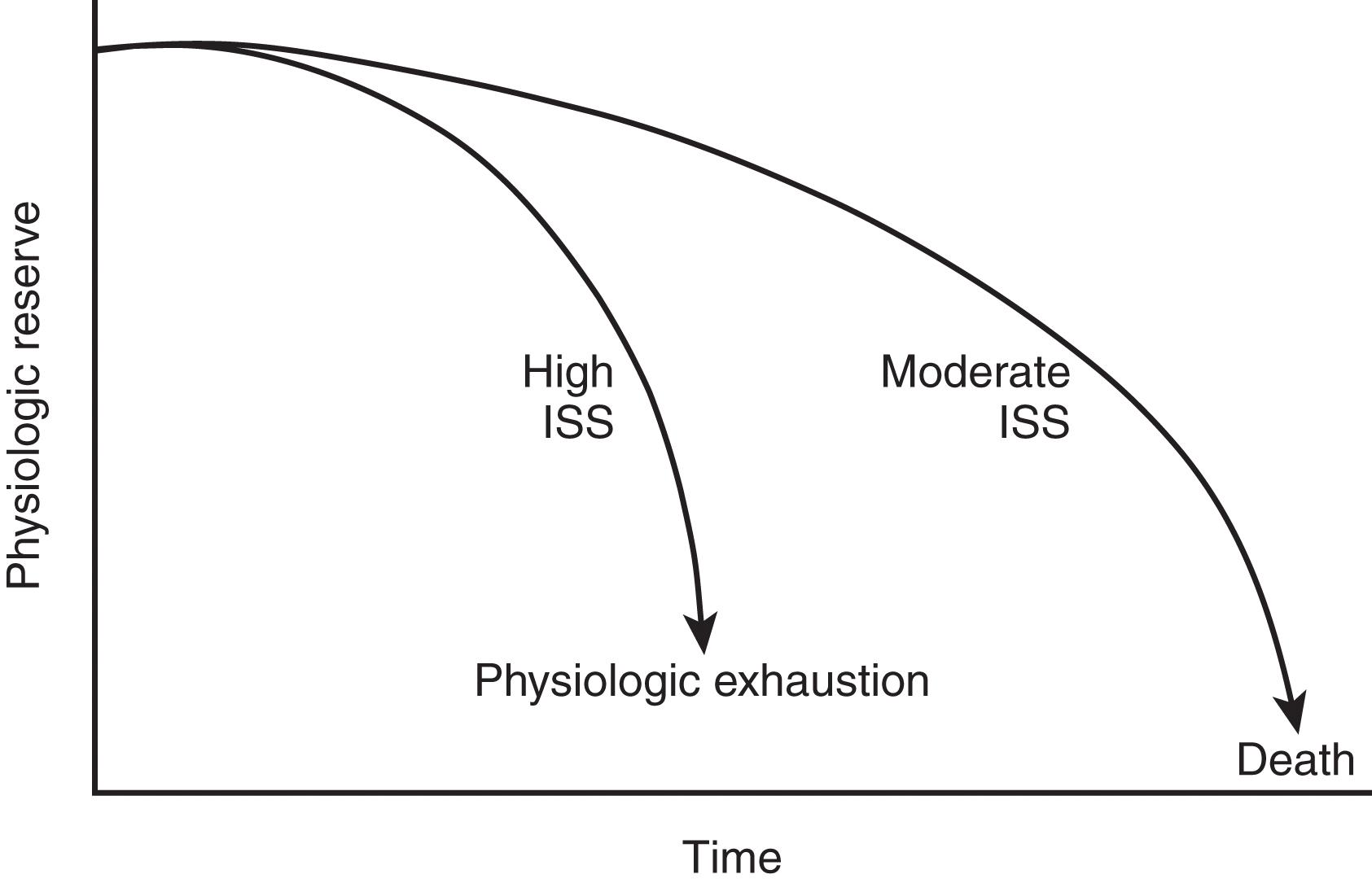
Perioperative communication with the anesthesia team enhances survival and reduces complications. This communication includes strategies to prevent hypothermia to include, increasing the room temperature and commercial warming devices (we prefer an underbody active convective warming device for all trauma laparotomies if possible), advising the anesthesia personnel of anticipated blood loss, and avoiding overresuscitation before surgical control of hemorrhage.
During the initial laparotomy, the surgeon must recognize the need for immediate control of major hemorrhage and contamination with maximum replacement of coagulation factors including platelets, plasma, and cryoprecipitate. Intraoperative monitoring of temperature, arterial blood gases, and volume of resuscitation are important in determining whether a patient is descending down the physiologic curve the “lethal triad.” In addition, for patients suffering hollow viscus injuries, contamination is controlled with linear staples to transect the bowel ends and leave them in discontinuity or rapid, primary suture closure until the patient can physiologically tolerate definitive reconstruction.
Clinical parameters have been identified that should prompt the surgical team to initiate damage control maneuvers, abort the operation, and return to the ICU for resuscitation and restoration of normal physiologic parameters (DC2) ( Table 2 ). Damage control should be instituted early, well before reaching the upper limits of physiologic exhaustion. Using these intraoperative predictors of the need for damage control, Asensio and associates, in a follow-up study, proved that patients with posttraumatic open abdomen incurred less hypothermia and fewer postoperative complications including intraabdominal abscess and fistula formation. Patients with early damage control were also subjectively noted to have less bowel edema and were more likely to undergo definitive abdominal wall closure during their initial hospitalization.
| Problem | Description |
|---|---|
| Hypothermia | <35° C |
| Acidosis | pH < 7.2 |
| Base deficit (BD) ≥ –8 mEq/L | |
| Lactate ≥ 4 | |
| Coagulopathy | Activated partial thromboplastin time (aPTT) > 60 |
| International normalized ratio > 1.6 | |
| Ongoing resuscitation | Persistent shock systolic blood pressure < 90 mm Hg |
| >10 L crystalloid | |
| >10 units packed red blood cells | |
| Operative time | >60–90 minutes with abdominal cavity opened |
Asensio and colleagues, in a hallmark study involving 548 patients who exsanguinated and required damage control, described and statistically validated criteria to enable the early institution of damage control. These criteria include pH lower than 7.2, HCO 3 − 15 mEq/L or less, temperature 34° C or lower, ≥12,000 mL of total volume replaced, and up to 4000 mL (10 to 12 units) of packed red blood cells.
Once a patient fulfills the requirements for damage control or is decompressed for signs and symptoms of ACS, the surgeon must commit the patient to the posttraumatic open abdomen and a TAC ( Box 3 ).
Depletion of physiologic reserve
Unable to close fascia without undue tension secondary to bowel edema
To avoid development of abdominal compartment syndrome after large fluid resuscitation
Planned return to operating room
Unpacking
Reestablish bowel continuity
Enteral access
Thorough exploration to reevaluate known injuries and identify missed injuries
Associated need for management of extra-abdominal life-threatening injuries (e.g., major pelvic fracture, severe closed head injury)
TAC is defined as any technique that contains the abdominal viscera during the acute phase of care. Historically, a wide variety of techniques for TAC have been used to contain the abdominal viscera during the acute phase of care ( Box 4 ). Despite multiple options for TAC, our current practice is to use a commercially available negative pressure therapy device, typically the ABTHERA system. It is our opinion that these commercially available systems best fulfill the first two principles in the management of the posttraumatic open abdomen: (1) protecting the bowel and (2) preserving the fascia. This system contains a sterile, perforated, nonadherent plastic layer with absorbent foam built into the plastic sheet, which can be cut to size and placed in a subfascial position. It is then covered with another foam layer, covered in adherent plastic stuck to the skin, and then connected to a negative pressure wound vacuum system. Previously our group used the “vacuum pack” method, as described by Barker and associates, which protects the bowel and abdominal viscera by placing a perforated, nonadherent plastic material over the abdominal contents placed in a subfascial position. This is followed by placement of a surgical towel with two large drains, which are brought out through the superior portion of the wound ( Fig. 8 ). The entire abdominal defect is covered with a large adhesive dressing and the drains are attached to wall suction to create continuous negative pressure. This technique also counteracts the lateral retraction of the fascial edges and preserves the rectus musculofascial complex for subsequent closure ( Box 5 ). While there is increased cost inherent with the ABTHERA system, it was demonstrated by Frazee et al in an article published in the Journal of the American College of Surgeons , that ABTHERA system led to significantly greater success with ultimate closure after damage control laparotomy as compared to the Barker technique and ultimately, the cost was offset by these findings.
Bogota bag
Towel clips
Zipper
Wittman patch
Skin-only closure
Barker vacuum pack
Negative-pressure wound systems
Prosthetic mesh
Gauze packs
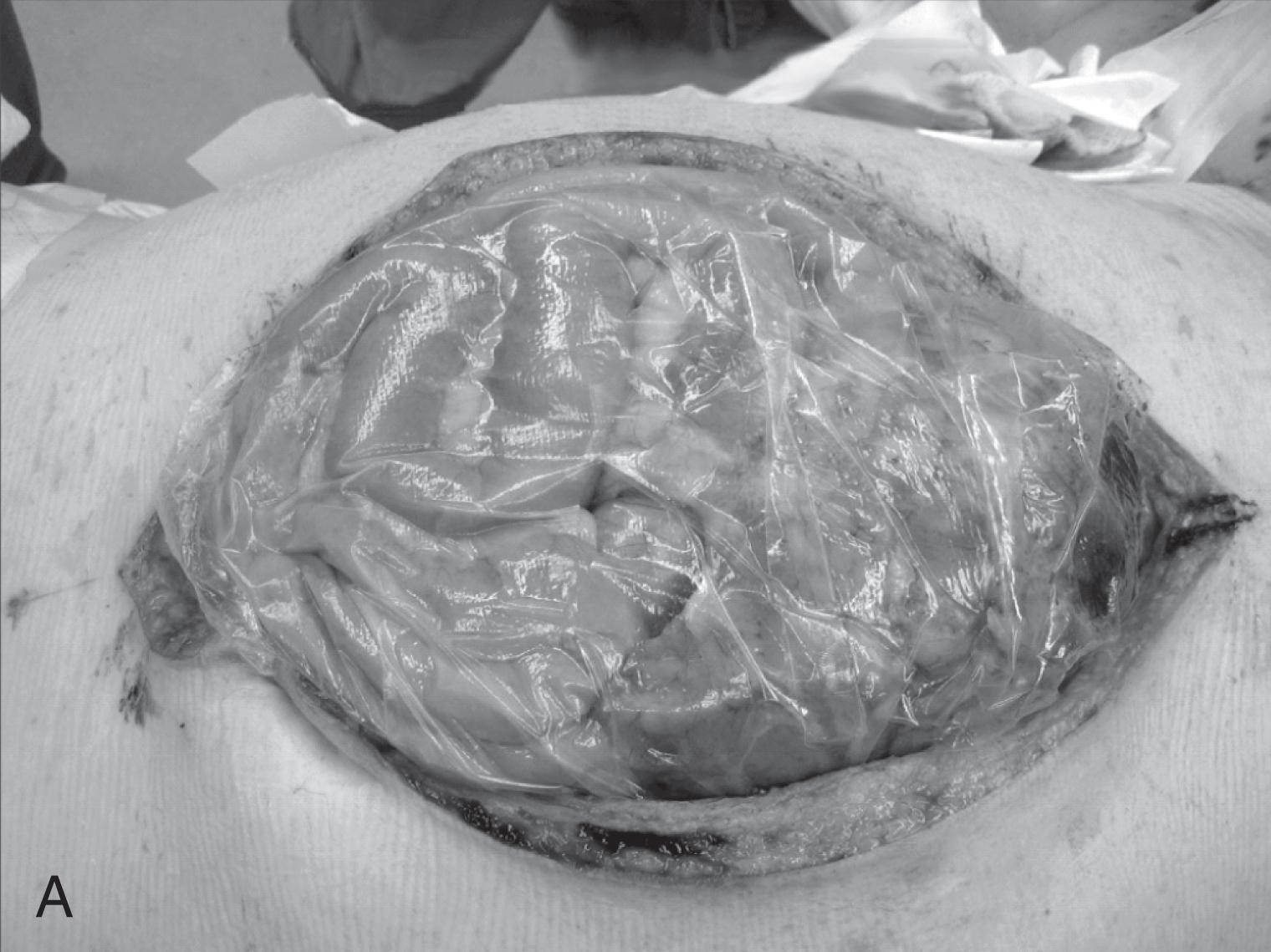
Protects bowel and keeps it below fascia
Preserves fascia and prevents loss of domain
Readily available, rapidly applied, easily removed
Keeps patient dry and maintains hygiene
Quantifies fluid loss
Prevents intraabdominal hypertension/abdominal compartment syndrome
Simple, atraumatic, and inexpensive
The ultimate goal in the management of the open abdomen is to achieve delayed primary fascial closure. However, certain clinical scenarios preclude closure or present technical challenges to successful primary fascial closure, and continued open abdomen management may be necessary. These patients may demonstrate ongoing contamination and physiologic insult, a prolonged inflammatory response with grossly distended viscera, an anticipated need for reoperation in 12 to 96 hours, or loss of abdominal domain. In these patients, serial TAC is indicated while strategies for a delayed primary closure versus abdominal wall reconstruction are made.
Three potential stages follow TAC:
Resuscitation in the ICU until physiologic end points of resuscitation are met
Restoration, or reoperation and attempts at early fascial closure (days to weeks)
Reconstruction, or planned ventral hernia and delayed fascia closure
The goals of the resuscitation in the ICU after damage control or decompressive laparotomy for ACS are repayment of the sustained oxygen debt, restoration of adequate perfusion to meet metabolic needs, and reversal of hemorrhagic shock. This includes coagulopathy correction, clearance of lactic acidosis, correcting electrolyte disturbances, and rewarming ( Box 6 ). Serial monitoring of abdominal pressure should be considered as the risk of ACS is high in this patient population. For patients who exhibit ongoing blood transfusion requirement despite normalization of temperature, acid-base status, and coagulopathy, prompt surgical reexploration should be considered as this would indicate inadequate hemorrhage control.
Become a Clinical Tree membership for Full access and enjoy Unlimited articles
If you are a member. Log in here